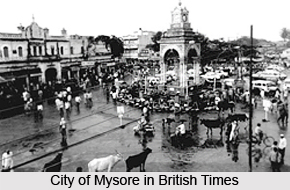 Wodeyar Dynasty during British rule played a most vital role in developing Mysore, as princely State. Wodeyar Dynasty also spelt as Wodeyar Dynasty, an Indian royal dynasty that ruled the Kingdom of Mysore from 1399 to 1947, until the sovereignty of India from rule of British Government in India and the subsequent unification of Indian dominion and princely states into the Republic of India.
Wodeyar Dynasty during British rule played a most vital role in developing Mysore, as princely State. Wodeyar Dynasty also spelt as Wodeyar Dynasty, an Indian royal dynasty that ruled the Kingdom of Mysore from 1399 to 1947, until the sovereignty of India from rule of British Government in India and the subsequent unification of Indian dominion and princely states into the Republic of India.
After restoring the Wadiyar or the Wodeyars to the throne of Mysore, by the British East India Company as Dual Independent state political governance, the British shifted the capital back to the city of Mysore from Srirangapatna.
Krishna Raja Wadiyar III, son of the last Wodeyar King Chamaraja Wodeyar VIII, was anointed as the King of Mysore, as a minor ruler of Mysore. From that time onwards, Wadiyars or Wodeyars were the subsidiaries of the British East India Company. The Wodeyers had to pay annual subsidy to the British East India Company.
However British took over the supervision of the Mysore Kingdom on an erroneous appeal of non-payment of financial support from Mummudi Krishna Raja Wadiyar in 1831 and British appointed commissioners were in charge of the Kingdom. British Commissioners administered Mysore from 1831 to 1881.
But in 1868, after the Transfer of power from the British East India Company to the British Government, the British Parliament upheld the King`s plea and decided to restore the Kingdom back to his adopted son Chamaraja Wadiyar IX. In 1881, transfer of power back to the Wadiyars or Wodeyars heralded an important phase in the making of modern Mysore. For the first time in India, democratic experiments were introduced by the constitution of the representative assembly. His son Nalvadi Krishna Raja Wodeyar earned great fame as a saintly King-Rajarishi and his Kingdom was hailed as Ramarajya by Mahatma Gandhi; an ideal kingdom comparable to the one ruled by the historical hero Lord Rama.
Under the supremacy of British Government, the Wadiyars or Wodeyar, freed from security concerns, shifted attention to the patronage of the fine arts. Under their patronage, Mysore became a cultural centre of Karnataka, fostering a number of famous musicians, writers and painters.
The last king of the Wadiyar dynasty was Jayachamaraja Wodeyar. He ruled from 1940 until Indian independence from British rule. In the year 1947, after India attained independence, he acceded his Kingdom to the dominion of India, but continued as the Maharaja until India became a Republic in 1950. He became the "Raja Pramukh"-a constitutional position, as the head of Mysore within the Republic of India from 1950-1956. After the re-organization of Indian States on linguistic basis, he was appointed as the Governor of the integrated Mysore in the year 1956, which post he held until 1964. After that he was Governor of Tamil Nadu for two years. But the Indian Constitution continued to recognize him as the Maharaja of Mysore until 1971, when Indira Gandhi, then Prime Minister of India abolished the titles and Privy Purse of well over 560 Maharajas spread over different parts of India. Jayachamaraja Wodeyar died in the year 1974.



















